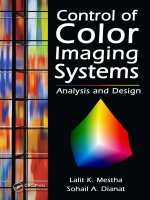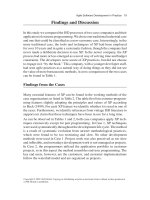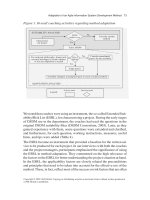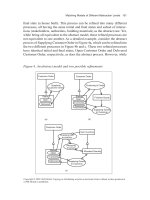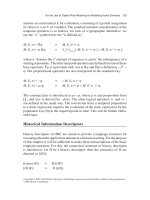mestha, dianat - control of color imaging systems. analysis and design
Bạn đang xem bản rút gọn của tài liệu. Xem và tải ngay bản đầy đủ của tài liệu tại đây (17.27 MB, 698 trang )
Analysis and Design
CRC Press is an imprint of the
Taylor & Francis Group, an informa business
Boca Raton London New York
Lalit K. Mestha
Sohail A. Dianat
CRC Press
Taylor & Francis Group
6000 Broken Sound Parkway NW, Suite 300
Boca Raton, FL 33487-2742
© 2009 by Taylor & Francis Group, LLC
CRC Press is an imprint of Taylor & Francis Group, an Informa business
No claim to original U.S. Government works
Printed in the United States of America on acid-free paper
10 9 8 7 6 5 4 3 2 1
International Standard Book Number-13: 978-0-8493-3746-8 (Hardcover)
This book contains information obtained from authentic and highly regarded sources. Reasonable
efforts have been made to publish reliable data and information, but the author and publisher can-
not assume responsibility for the validity of all materials or the consequences of their use. The
authors and publishers have attempted to trace the copyright holders of all material reproduced
in this publication and apologize to copyright holders if permission to publish in this form has not
been obtained. If any copyright material has not been acknowledged please write and let us know so
we may rectify in any future reprint.
Except as permitted under U.S. Copyright Law, no part of this book may be reprinted, reproduced,
transmitted, or utilized in any form by any electronic, mechanical, or other means, now known or
hereafter invented, including photocopying, microfilming, and recording, or in any information
storage or retrieval system, without written permission from the publishers.
For permission to photocopy or use material electronically from this work, please access www.copy-
right.com ( or contact the Copyright Clearance Center, Inc. (CCC), 222
Rosewood Drive, Danvers, MA 01923, 978-750-8400. CCC is a not-for-profit organization that pro-
vides licenses and registration for a variety of users. For organizations that have been granted a
photocopy license by the CCC, a separate system of payment has been arranged.
Trademark Notice: Product or corporate names may be trademarks or registered trademarks, and
are used only for identification and explanation without intent to infringe.
Library of Congress Cataloging-in-Publication Data
Mestha, L. K.
Control of color imaging systems : analysis and design / authors, L.K. Mestha
and Sohail A. Dianat.
p. cm.
“A CRC title.”
Includes bibliographical references and index.
ISBN 978-0-8493-3746-8 (alk. paper)
1. Imaging systems Automatic control. 2. Color display systems Automatic
control. 3. Digital printing Automatic control. 4. Image processing Digital
techniques. 5. Color printing. I. Dianat, Sohail A. II. Title.
TK8315.M47 2009
681’.62 dc22 2008054552
Visit the Taylor & Francis Web site at
and the CRC Press Web site at
Dedication
This book is dedicated to
our families, Suhan, Savan, and Veena Mestha,
Ahrash Dianat, and Mitra Nikaein
Contents
Preface xv
Acknowledgments xix
Chapter 1 An Overview of Digital Printing Systems 1
1.1 Introduction 1
1.2 Printing and Publishing System 1
1.2.1 Business Management 2
1.2.2 Output Production 2
1.2.3 Process Management 5
1.3 Digital Front End 5
1.4 Digital Print Engine (Electrophotographic) 6
1.4.1 Image-on-Image and Tandem Print Engines 7
1.4.2 Parallel Printing Systems 8
1.5 Evolution of Controls Technology for Digital
Printers—Color Controls View 10
1.6 Prepress-Based Processing 13
1.7 DFE-Based Processing 15
1.8 Print Engine-Based Processing 16
References 17
Chapter 2 Fundamentals of Digital Image Processing 19
2.1 Introduction 19
2.2 Digital Image Formation and Systems 19
2.2.1 Point Spread Function of a Defocused Lens 20
2.2.2 Point Spread Function of Motion Blur 21
2.2.3 Point Spread Function of Human Visual System 22
2.3 Optical and Modulation Tr ansfer Functions 22
2.4 Image Sampling and Quantization 28
2.4.1 Two-Dimensional Sampling Theorem 31
2.4.2 Image Quantization 34
2.4.2.1 Uniform Quantization 34
2.4.2.2 Signal-to-Quantization Noise Ratio (SQNR) 35
2.4.2.3 Optimum Minimum Mean-Square Error Quantizer 36
2.4.2.4 Perceptual Quantization 40
2.4.2.5 Vector Quantization 41
2.5 Image Transform 46
2.5.1 Two-Dimensional Discrete Fourier Transform 46
2.5.2 Two-Dimensional Discrete Cosine Transform 57
vii
2.5.3 Two-Dimensional Hadamard Tra nsform 58
2.5.3.1 Inverse Hadamard Transform 59
2.6 Image Filtering 60
2.6.1 Design of 2-D FIR Filters 64
2.7 Image Resizing 68
2.7.1 Definition of Sampling Rate Conversion 68
2.7.2 Upsampling by Factor of P 69
2.7.3 Downsampling by Factor of Q 70
2.7.4 Sampling Rate Conversion by a Factor of
P
Q
72
2.7.5 Examples of Low-Pass Filters Used for Sampling
Rate Conversion 72
2.8 Image Enhancement 77
2.8.1 Unsharp Masking 77
2.8.2 Image Histogram 78
2.8.3 Histogram Equalization 80
2.9 Image Restoration 82
2.9.1 Wiener Filter Restoration 83
2.10 Image Halftoning 85
2.10.1 Error Diffusion Algorithm 88
Problems 91
References 97
Chapter 3 Mathematical Foundations 99
3.1 Introduction 99
3.2 General Continuous-Time System Description 99
3.2.1 Solution of Constant-Coefficients Linear
Differential Equations 100
3.3 Laplace Transform 102
3.3.1 Inverse Laplace Transform 104
3.4 General Linear Discrete-Time Systems 107
3.4.1 Solution of Constant-Coefficients Difference Equations 108
3.5 z-Transform 110
3.5.1 Properties of z-Transform 113
3.5.2 Inverse z-Transform 120
3.5.3 Relation between the z-Transform and the Laplace Transform 125
3.6 Discrete-Time Fourier Transfor m 127
3.6.1 Properties of Discrete-Time Fourier Transform 127
3.6.2 Inverse DTFT 128
3.7 Two-Dimensional z-Transform 129
3.8 Two-Dimensional Discrete-Space Fourier Transform 131
3.8.1 Properties of 2-D DSFT 132
3.8.2 Inverse 2-D DSFT 132
3.9 Eigenvalues and Eigenvectors 134
3.9.1 Definition of Eigenvalue and Eigenvector 134
3.9.2 Product and Sum of Eigenvalues 137
viii Contents
3.9.3 Finding Characteristic Polynomial of a Matrix 138
3.9.4 Modal Matrix 139
3.9.5 Matrix Diagonalization 140
3.9.6 Definite Matrices 142
3.10 Singular Value Decomposition 144
3.10.1 Matrix Norm 146
3.10.2 Principal Components Analysis 150
3.11 Matrix Polynomials and Functions of Square Matrices 155
3.11.1 Matrix Polynomial 156
3.11.2 Infinite Series of Matrices 156
3.11.3 Cayley–Hamilton Theorem 157
3.11.4 Function of Matrices 159
3.11.4.1 Cayley–Hamilton Technique 159
3.11.4.2 Modal-Matrix Technique 161
3.11.5 Matrix Exponential Function e
At
163
3.11.6 Computing e
At
Using Laplace Transform 165
3.11.7 Matrix Exponential Function A
k
166
3.12 Fundamentals of Matrix Calculus 168
3.12.1 Derivatives of a Scalar Function with Respect to a Vector 168
3.12.2 Derivatives of Quadratic Functions 170
3.12.3 Derivative of a Vector Function with Respect to a Vector 172
Problems 172
References 176
Chapter 4 State-Variable Representation 177
4.1 Introduction 177
4.2 Concept of States 177
4.3 State-Space Representation of Continuous-Time Systems 177
4.3.1 Definition of State 177
4.3.2 State Equations of Continuous-Time Systems 178
4.3.3 State-Space Equations of Electrical Systems 179
4.3.4 State-Space Equations of Mechanical System s 182
4.4 State-Space Representation of General Continuous LTI Systems 185
4.4.1 Controllable Canonical Form 186
4.4.2 Observable Canonical Form 186
4.4.3 Transfer Function (Matrix) from State-Space Equations 187
4.5 Solution of LTI Continuous-Ti me State Equations 188
4.5.1 Solution of Homogeneous State Equation 188
4.5.2 Computing State-Transition Matrix 189
4.5.3 Complete Solution of State Equation 191
4.6 State-Space Representation of Discrete-Time Systems 193
4.6.1 Definition of State 193
4.6.2 State Equations 194
Contents ix
4.7 State-Space Representation of Discrete-Time LTI Systems 195
4.7.1 Controllable Canonical Form 195
4.7.2 Observable Canonical Form 196
4.7.3 Transfer Function (Matrix) from State-Space
Equations 197
4.8 Solution of LTI Discrete-Time State Equations 198
4.8.1 Solution of Homogeneous State Equation 198
4.8.2 Computing State-Transition Matrix 199
4.8.3 Complete Solution of State Equations 201
4.9 Controllability of LTI Systems 203
4.9.1 Definition of Controllability 203
4.9.2 Controllability Condition 204
4.10 Observability of LTI Systems 205
4.10.1 Definition of Observability 206
4.10.2 Observability Condition 206
Problems 209
References 213
Chapter 5 Closed-Loop System Analysis and Design 215
5.1 Introduction 215
5.2 State Feedback 215
5.2.1 Basic Con cept 215
5.2.2 Pole-Placement Design of SISO Systems 219
5.2.3 Pole-Placement Design of Multiple-Input
Multiple-Output (MIMO) Systems 224
5.2.4 Relationship between Poles and the Closed- Loop
System Response 227
5.3 LQR Design . 227
5.3.1 Introduction . 227
5.3.2 Solution of the LQR Problem 229
5.3.3 Steady-State Algebraic Riccati Equation 233
5.4 State Estimators (Observers) Design 234
5.4.1 Introduction . 234
5.4.2 Full-Order Observer Design 234
5.4.3 Reduced-Order Observer Design 238
5.5 Combined State Estimation and Control 240
5.5.1 Introduction . 240
5.5.2 Combined Controller and Observer 240
Problems 244
References 247
Chapter 6 Interpolation of Multidimensional Functions 249
6.1 Introduction 249
6.2 Interpolation of Uniformly Spaced Lookup Tables 250
6.2.1 Linear and Bilinear Interpolations 250
6.2.2 Trilinear Interpolation 254
x Contents
6.2.3 Tetrahedral Interpolation 257
6.2.4 Sequential Linear Interpolation 262
6.3 Nonuniformly Spaced Lookup Tables 264
6.3.1 Shepard Interpolation 264
6.3.2 Moving-Matrix Interpolation 267
6.3.3 Recursive Least-Square Implementation
of Moving-Matrix Algorithm 269
6.4 Lookup Table Inverse 270
6.4.1 Introduction 270
6.4.2 Inverse Printer MAP 270
6.4.3 Iteratively Clustered Interpolation 272
6.4.3.1 Selection of Step Size Parameter m 273
6.4.3.2 Algorithm Initialization 274
6.4.4 Tetrahedral Technique 274
6.4.5 Conjugate Gradient Approach 275
6.4.6 Comparison of Different Inversion Algorithms 276
6.5 Compression of Lookup Tables 277
6.5.1 Introduction 277
6.5.2 Downsampling Using Sequential Linear Interpolation 278
6.5.3 Dynamic Optimization Algorithm 278
6.5.3.1 One-Dimensional DO Algorithm 278
6.5.3.2 Two-Dimensional DO Algorithm 280
6.5.3.3 Three-Dimensional DO Algorithm 281
6.6 Smoothing Algorithm for Multidimensional Functions 286
6.6.1 Introduction 286
6.6.2 Multidimensional Smoothing Algorithm 288
6.6.2.1 One-Dimensional Smoothing Algorithm 288
6.6.2.2 Two-Dimensional Smoothing Algorithm 289
6.6.2.3 Three-Dimensional Smoothing Algorithm 290
6.6.3 Application to Printing Systems 293
Problems 295
References 301
Chapter 7 Three-Dimensional Control of Color Management Systems 303
7.1 Introduction 303
7.2 Image Path Architecture 303
7.3 Profiling—A Complex System Problem 305
7.3.1 Tight Color Rendition Requirements 305
7.3.2 Gamut Limitation 306
7.3.3 Smoothness 306
7.3.4 ICC Workflow 307
7.3.5 Engine Conditions 307
7.4 Characterization of Color Systems 308
7.4.1 Least-Squares Estimation 308
7.4.1.1 A Linear in the Parameters Model 309
Contents xi
7.4.1.2 Recursive Least-Squares Estimation Algorithm 310
7.4.1.3 Piecewise Linear Models 313
7.4.2 Principal Component Analysi s-Based Model 321
7.4.2.1 PCA-Based Model in Spectral Space 321
7.4.2.2 PCA-Based Modeling for Adaptive Estimation 327
7.4.2.3 Log-PCA Model (Log-PCA) 329
7.4.2.4 Piecewise Linear PCA Model 329
7.4.2.5 Yule–Nielson Corrected PCA Model 330
7.4.3 Neugebauer Model 331
7.4.3.1 Parameterized Model for Neugebauer Weights 332
7.4.3.2 Dot Area Coverages and Neugebauer Weights 335
7.4.3.3 Estimation of Dot Area Coverages
Using Least Squares 337
7.4.3.4 Cellular Neugebauer Model (Lab-NB) 339
7.4.4 Device Drift Model 344
7.4.4.1 Autoregressive (AR) Model Applied to Printer
Drift Prediction 344
7.4.4.2 Vector Autoregressive Model Applied to Printer
Drift Prediction 347
7.5 GCR Selection and Inversion 350
7.5.1 A Simple GCR Function 351
7.5.2 Inversion of a Three-to-Three Forward Map 353
7.5.2.1 Inverse by Working on the Printer Model 354
7.5.2.2 Control-Based Inversion 355
7.5.2.3 Inverse by Iterating Directly on the Printer 359
7.5.3 Brief Review of GCR Methods 362
7.5.4 GCR Constrained 4-to-3 Inverse 364
7.5.4.1 A 4-to-3 Control-Based Inversion 365
7.5.4.2 K-Restricted GCR 366
7.5.4.3 Tricolor GCR 377
7.5.5 GCR Retri eval from Historical Profiles 379
7.5.6 K-Suppression Methods . 382
7.6 Gamut-Mapping Methods 384
7.6.1 Gamut Mapping with Ray-Based Control Model 385
7.6.2 Centroid Clipping 392
7.6.3 Soft Gamut Mapping with Ray-Based Control Model 393
7.6.4 Gamut Mapping for Constant Lightness and Hue 395
7.6.5 Merit-Based Gamut Mapping 396
7.6.6 Black Point Compensation 398
7.7 Evaluation of Profiles 399
7.7.1 Gamut Utilization and Round Trip Accuracy 399
7.7.2 Gamut Corner Plots and Neutral Response . 400
7.7.3 Visual Evaluation of Profiles 406
7.8 An Example Showing How to Build Multidimensional Inverse LUT 412
Problems 421
References 422
xii Contents
Chapter 8 One-Dimensional, Two-Dimensional, and Spot-Color
Management and Control Methods 431
8.1 Introduction 431
8.2 Principles of Color Management 432
8.3 One-Dimensional Gray-Balance Calibration 433
8.4 Two-Dimensional Calibration 435
8.5 One-Dimensional and Two-Dimensional Printer Calibration
Using Print er Models 436
8.5.1 One-Dimensional Channel-Wise (Independent)
Calibration 436
8.5.2 Gray-Balanced Calibration 438
8.5.3 Two-Dimensional Calibration 442
8.6 One-Dimensional and Two-Dimensional Printer Calibration
with State-Feedback Methods 445
8.6.1 Pole-Placement Design 449
8.6.2 Highlight and Shadow Corrections 450
8.6.2.1 Highlight Corrections 453
8.6.2.2 Shadow Corrections 454
8.6.3 Two-Dimensional Printer Calibration
with State-Feedback Methods 455
8.6.4 Predictive Gray Balance 457
8.7 Spot-Color Control 459
8.7.1 Gamut Mapping for Spot-Color Control 464
8.7.2 Gamut Classes 464
8.7.3 Control Algorithm 467
8.7.4 Control Algorithm with Ink Limits 467
Problems 469
References 470
Chapter 9 Internal Process Controls 471
9.1 Introduction 471
9.2 Process Control Models—A General Control View 472
9.3 Time Hierarchical Process Control Loops 477
9.4 Level 1 Electrostatic Control System 477
9.4.1 Electrostatic Controller Design 483
9.5 State Space to Transfer Function Conversions 486
9.6 Level 2 Developability Controller 488
9.6.1 Jacobian Matrix for Developability Control 491
9.7 Steady-State Error 494
9.8 Design of the Gain Matrix 496
9.9 Level 3 Control Loops 501
9.9.1 Static TRC Inversion Process 505
9.9.2 Control-Based TRC Inversion Process 509
9.10 Dead Beat Response 513
Contents xiii
9.11 TC Control Loop 515
9.11.1 Open-Loop TC Model 515
9.11.2 Design of a TC Control Loop Using a PI Controller 517
9.11.3 Design of a TC Control Loop with a Time Delay
Using a PI Controller 522
9.11.4 Feedforward Compensation for Image Disturbance 525
9.11.5 Design of TC Control Loop with State Feedback
Controller and State Estimator 526
9.12 Process Controls Under Limited Actuation 530
9.13 Optimal Controls for Selective States 539
9.14 Optimal Measurements 543
Problems 549
References 552
Chapter 10 Printing System Models 557
10.1 Introduction 557
10.2 Process Models 557
10.2.1 Charging Model 558
10.2.2 Exposure Model 562
10.2.3 Development Model 569
10.2.4 Transfer Model 577
10.2.5 Fusing Model 584
10.2.6 Color Model . 586
10.2.6.1 Sensitivity Analysis of the Model 593
10.3 Modulation Transfer Functions 597
10.4 Tone Reproduction Curve 605
10.5 Image Simulation with Fusing and Color Models 606
10.6 Virtual Printer Color Gamut 608
10.7 Virtual Printer Model Tuning to an Experimental Printer 610
10.7.1 Tuning Toner Master Curves 610
10.7.2 Tuning of Single Separation Coefficients . 612
10.7.3 Determination of Color Mixing Coefficients {C
ji
} 613
10.7.4 One-Dimensional Channel-Wise TRC Matching 615
10.7.5 Tuning Res ults 617
10.7.6 Summary 618
Problems 618
References 619
Appendix A 623
Appendix B 641
Appendix C 645
Index 647
xiv Contents
Preface
Digital color printing technology offers many new avenues and opportunities for
rendering color pages on demand at a lower run cost as compared with conventional
printing. Many digital printers are based on electrophotographic technology, which
is used in the process of laser printing. In this process, the image content controls the
amount of light that selec tively discharges a uniformly charged photoreceptor mater-
ial with a laser or light emitting diodes to form an image. The electrostatic image
is then developed with a thermoplastic powder containing charged pigment that is
transferred and fused to paper under heat and pressure. The quality and productivity
issues of these devices are addressed using a variety of new technologies including
optical sensing, imaging, and closed loop feedback controls. Since the process tends
to vary more over time, print quality defects and subtle variations in output are more
noticeable in color printing than in monochrome printing. Also, color is rendered on
different imaging devices (variety of printing and display devices) with varying color
capabilities. As a result, the ability to produce accurate and pleasing color across
numerous output devices is extremely complex and, to some extent, impossible. This
is further made difficult due to variation in the workflow requirements, stocks and
environment.
Practical feedback control systems used in digital production printers touch on a
range of interconnected subsystems. Although there are numerous digital printers
serving today’s market, many new challenges must be overcome to improve the
output quality and enable further growth and opportunity. At a system level, a good
basic under standi ng of the e nd-to- end c olor prin ting pr ocess ma y be helpf ul and at
a subsystem level, theoretical knowledge of the physical printing process, device
technology, and the principles associated w ith electronic imaging. Someone new
to the field, who could be a researcher, a practitioner, or a student, should have a
good foundation in the major disciplines used for managing & controlling color in
digital production printers. Unlike off-set printers, digital printers offer many new
actuators that give control engineers access to numerous process steps (e.g., laser
intensity, toner mass, CMYK primaries etc.) for developing real-time, closed-loop
algorithms and architectures that can be self-tuned using various sensors along the
print path and self-corrected for process variations and uncertainties.
Although an extensive number of patents and conference papers have been
written on the control of digital color printing, to the best of our knowledge, no
design books have been written on this subject matter. This book brings together the
numerous complex disciplines associated with digital color printing and presents a
technical story with proper mathematical rigor and design examples. The objective
of this book is to provide a good understanding of fundamental techniques and push
the front ier of this field. We have attempted to keep the mathematics at a moderate
level. So, it can also be used as a textbook for an introductory course in printing,
digital control, digital ima ging systems, color management and control, color print-
ing etc., at a senior level or at a first-year graduate level . In our opinion, it is also
xv
suitable for a graduate level course in imaging and computer applications. Addition-
ally, this book can serve as a reference for instructors or a self-learning book for
practicing eng ineers.
The material covered in this book is based on our 27 years of combined
experience in applying control algorithms to modern digital printing systems,
where precision color controls and sensing are needed to achieve offset quality
color images. This book also captures some of our combined experience of over
30 years in teaching fundamental courses in engineering, especially in the areas of
digital signal=image processing, moder n control theory, color, and applied linear
algebra. This book largely discusses the imaging systems developed over recent
years, which have appeared as products for automating color consistency in digital
presses. They use algorithms and capabilities far beyond standard printing and
copying machines.
It is assumed that the readers have a basic understanding of color, linear system
theory (both continuous and discrete), including topics like convolution and Fourier
analysis. The contents of the book are outlined as follows: Chapter 1 provides an
overview of digital printing systems, workflows of data, digital front-end system, and
the major elements in an end-to-end production print path. Chapter 2 covers some
fundamental topics, which form the cornerstone of digital image processing, such as
digital image formation, sampling and quantization, image coding, image transform,
optical and modulation transfer function, and image de-noising. Chapter 3 covers the
mathematical tools needed for the analysis and design of feedback control systems.
Topics such as differential and difference equations (DE), the numerical solution of
DE, the z-transform and its properties, the relationship between the z-transform and
the Laplace transform , and the pulse transfer function are described. Chapter 4 deals
with state variable techniques used to analyze continuous and discrete linear systems.
State variable representation, state transition matrix, the solution of state equations,
controllability, observability, and stability of linear systems are major topics dis-
cussed in this chapter. Techniques for closed-loop linear system analysis and design
are covered in Chapter 5. Design techniques such as pole placement for single-input
single-output (SISO) as well as multi-input multi-output systems (MIMO) and linear
quadratic regulator design are among the topics that are covered in this chapter.
Chapter 6 explains different techniques used for interpolation of multidimensional
functions. Techniques such as trilinear interpolation, tetrahedral interpolation ,
sequential linear interpolation, Shepard, moving matrix, iterative clustered interpol-
ation (ICI) algorithm, dynamic optimization and 1-D, 2-D, 3-D smoothing algo-
rithms are described. Chapter 7 covers the 3-D control of color management syst ems
with International Color Consortium (ICC) profiles generated using gray-component
replacement (GCR) constraints, control-based inversion and control-based gamut
mapping approaches. In this chapter, various empirica l and first principle based
Neugebauer models are covered in detail. In Chapter 8, the basics of 1-D and 2-D
tone control of color management systems are discussed. State variable representa-
tion of imaging systems, control-based 1-D and 2-D tone management, and spot
color control methods are presented. In Chapter 9, a detailed modeling and analysis
of internal closed-loop process controls, closed-loop controller design for charging and
development systems are presented. Current best practices used in toner concentration
xvi Preface
system modeling with time delay & controller design for time delay systems are
covered. Optical sensing methods used for measuring various process outputs
(e.g., toner density measurements on photoreceptors), including measurement of
spectral functions of color are considered beyond the scope of this bo ok. Compon-
ents of a digital laser printing system, charging, exposure, development, transfer, and
fusing subsystems are modeled in Chapter 10.
The control theor y and methods presented in this book are state-of-the art for
color printing systems. We deliberately limit the control theory to MIMO pole
placement, state feedback and linear quadratic regulator design so that the math-
ematics is reasonably simple and can be taught at a senior undergraduate or a first
year graduate level class in color, imaging, con trol or compu ter engineering discip-
lines. Formulations and illustrations presented emphasize simplicity so that the
readers can easily understand the concepts and use them in their systems in the
same way we did for high-end printers. Emphasis is on essential theoretical design
principles and algorithms needed to build high quality, accurate, and offset-like
output at lower cost through automation. Whil e constructing end-to-end system
models with process and subsystem parameters, we tried to capture the meaningful
& essential behavior of subsystems in terms of parameters accessible for designing
control systems. System models are presented in Chapter 10 to provide a nonlinear
simulation platform for students, faculty and practicing engineers to explore more
advanced approaches for desig ning future imaging systems that compare and con-
trast with experimental data when they become available. Tuning of model param-
eters is a rich area for applying modern system identification methods. Our approach
shown in Chapter 10, although elementary, is considered useful to bring some reality
to simulations since most control systems designed today are first simulated before a
real test is done. We hope this book will bridge the gap between current and future
theoreticians and practitioners, as well as generate new ideas, algorithms and
methods in imaging systems to achieve full autonomy.
Lalit K. Mestha
Sohail A. Dianat
Preface xvii
Acknowledgments
I would like to thank Graham Rees of Rutherford Appleton Laboratory, Professor
Richard Talman of Cornell University, Bob Webber of Fermi National Accelerator
Laboratory, and Professor Kai Yeung of the University of Texas at Arlington for
injecting the seeds of physics and controls into my mind before I moved on to Xerox
Research and realized the need for sophisticated learning when designing large scale
physical systems.
It was Dr. Charles B. Duke who brought me to Xerox Corporation while I was
looking for a new job in Texas and pondering my next big challenging control
application. Thanks to the support of his staff, he exposed me to the complex world
of digital color printing. Therefore, before I go any further, I would like to express
my most sincere gratitude and appreciation to Dr. Charles B. Duke. If it wasn’t for
him, my research would have been different and the book would have been written
on a different topic.
I would like to acknowledge and express special gratitude to my Senior Man-
agement, Sophie Vandebroek, Steve Hoover and Steve Bolte, who always gave me
the support I needed for carrying out the research and producing the text book, from
approval to completion, while trying to meet their business objectives. Several Indus-
try-University collaborations were initiated since I started writing the book in 1996: a
National Science Foundation’s Grant Opportunity for Academic LIason (GOALI),
New York State’s Center for Electronic Imaging Systems (CEIS), one of 15 NYSTAR
sponsored Centers for Advanced Technology (CATs) in the area of control theory and
electronic imaging. These academic relationships led to many important research
results. Industry-University interactions and teaching as an adjunct professor at the
University of Texas at Arlington and the Rochester Institute of Technology (RIT)
greatly improved my ability to internalize and leverage existing methods and algo-
rithms for real world system applications. Multi-dimensional smoothing, dynamic
optimization, linear MIMO state feedback, state variable methods, MIMO pole-
placement design, input-output experimental processes, principal component analy-
sis, singular value decomposition, optimal linear estimators, design approac hes for
time delay systems, anti-windup compensators for saturation, and system identifica-
tion are just a few of the methods that are now routinely used in our research
regarding next generation systems. Applying all of these methods and algorithms
is truly a great success for me, and I would like to acknowledge the support of all the
faculty members and students who worked with me for all of those years.
I would like to recognize my managers, Tracy E. Thieret, Michael R. Fu rst,
Debbie Wickham, Kenn eth J. Mihalyov, William J. Hannaway, Norm W. Zeck, and
Lisa Purvis, as well as Peter A. Crean, a senior research fellow, who have supported
me at various stages in my research career while developing my knowledge in color
and xerographic systems , and working with product development groups so that our
research led to the creation of value for our customers. I would like to especially
xix
thank Peter S. Fisher and Paul A. Kaufman of the Xerox Special Information
Systems group for supporting the early injection of our recent research solutions
into products.
Lalit K. Mestha
We would like to thank CEIS and Xerox Corporation for suppor ting our research in
the areas of control for imaging and printing applications over the past ten years.
Special thanks goes to Prudhvi Krishna Gurram, a PhD student at RIT, who not only
got his MSEE degree while working on the CAT funded research project, but also
contributed to the tuning of printing system models and read and edited the entire
manuscript. We would also like to thank Bruce Brewington, our student intern at
RIT, who helped us in developing a tensor based multidimensional smoothing
algorithm that is covered in this book. Nikolaos M. Freris and Kunal Srivatsava of
University of Illinois at Urbana-Champaign also worked in the early stages with us
while developing the Printing System models. Very special thanks to Palghat
Ramesh, a Principal Scientist at Xerox Corporation, without his efforts and guidance,
we would not have created the material for Chapter 10. Finally, it is Jack G. Elliot,
our colleague at Xerox Research, who carefully edited the proof line by line. Without
his focused effort and numerous suggestions, many errors may have gone to press
unnoticed.
Writing a book of this magnitude is a major undertaking and producing the
material for writing it is even harder. A special thanks to all the administrative staff,
scientists, engineers, technicians, and developers at Xerox Corporation who contrib-
uted to the growth of the technology with us over the years and made it useful to our
customers. Special thanks goes to Martin S. Maltz, a Principal Scientist at Xerox
Research, whose experience and intuition helped us to understand color, color
transforms and ICC profiles particularly well.
We thank Barbara Zimmerli, who greatly helped with the administrative support
while completing the final manuscript.
Lastly, we would like to thank our families, Suhan, Savan, and Veena Mestha,
Ahrash Dianat, and Mitra Nikaein, for their support and understanding when dedi-
cating our personal time on this project.
Lalit K. Mestha
Sohail A. Dianat
xx Acknowledgments
1
An Overview of Digital
Printing Systems
1.1 INTRODUCTION
The printing industry includes a number of segments [1] including commercial
printing and publishing. The integration of compu ting, imaging, and controls tech-
nology has enabled advanced digital color printing and publi shing systems for the
office and production.
In this chapter, we describe some of the key elements of an end-to-end digital
printing and publishing system used for the production of high print volumes and the
management of complex print jobs. This overview will help the reader to better
understand the functional and processing system-level components involved when
designing optimal printing systems.
1.2 PRINTING AND PUBLISHING SYSTEM
Printing and publishing is a large industry composed of many shops, that vary in
size. These shops use equipments based on a variety of printing methods. Litho-
graphy, letterpress, flexography, gravure, and screen-printing use plates or some
other form of image carrier, and digital or electronic printing such as electrostatic or
ink-jet is plateless. Lithography, often called ‘‘offset printing,’’ is the dominant
printing process in the industry. Flexography produces vibrant colors with little
rub-off qualitie s, valued for newspapers , directories, and books. Gravure’s high-
quality reproduction, flexible pagination and formats, and consistent print quality are
used in packaging and printing of periodicals.
In offset printing presses, the press control system controls and monitors the ink,
water, and print registration systems, and often robot s are used to move parts in and
out of the presses in print shops [2]. Unlike digital printers, the traditional offset
press does not allow the changing of pixels on page boundaries while printing. This
limitation brings new challenges and opportunities to the digital printing and pub-
lishing value chain.
Some publishing processes became digital for several reasons: (1) variable
information electronic documents containing fragments of text, graphics, and images
from either the electronic or the scanned input stream can be merged, edited, and
assembled into laid-out pages forming a complete job; (2) the printing technology
can handle digital stream of data; and (3) the benefits of digital data brought
additional value, for example, ‘print-on-demand’. This led to variable data printing
with a lower cost short run, personalization, and versioning, that is difficult to create
1
with offset print ing. Understanding some of the key steps involved in the printing
and publishing workflow can shed some light on the complexity of the system.
Workflows (various steps required all the way from receiving the orders in a print
shop to the production of a job in finished form) are generally unique to each print
shop. The typical workflows used in both areas of printing (digital and offset) can be
divided into three main components: (1) business management, (2) output produc-
tion, and (3) process management=supporting functions (see Figure 1.1 for a block
diagram view of the wor k flow process). It includes not just the actual production
steps, but all the necessary supporting tasks like billing, archival, etc.
1.2.1 BUSINESS MANAGEMENT
Business management tasks (the top portion of Figure 1.1) involve taking orders from
customers, and assigning job-tracking numbers for monitoring purposes. Order infor-
mation may include artwork, text, illustrations, design=layout, variable information
rules, demographic data, etc. Pricing is estimated for the order and compared with the
actual cost of running the job. Aspects related to handling the shipment of the finished
job, archiving, and billing are an integral part of business management functions.
Customers and sales=service representatives are involved at the order-taking stage. A
project manager handles the job tracking and billing issues.
1.2.2 OUTPUT PRODUCTION
After the order taking step, customer data flow into the output production stage (the
middle portion of Figure 1.1). This category can be further divided into creative,
prepress, print (press), finish, and fulfill stages. For high-volume, single-shipment,
sheet-oriented documents, offset presses are used. Customer data is directly sent to
the prepress area. For low-volume, multishipment, and variable information documents,
the customer data is processed in the creative stage before sending it to prepress. In the
creative stage, concepts and drawings are developed; documents are designed by
assembling the content using various layout tools. Image capture from scanner or
other document input devices are done in this stage.
Electronic documents are then sent to the prepress area for further processing and
assembly. Since documents could be of various formats and color spaces
(RGB=CMYK), proper design choices are required before converting the documents
to the language required by the raster image processor (RIP), which converts a
document’s strings of character codes to pixels. Generally speaking, the prepress
stage (see Figure 1.2) encompasses all the steps involved in creating a digital
electronic master. In a typical prepress system, multiple workstations are networked
together to serve as the publishing desktop for generating, editing, managing,
manipulating, and integrating multimedia content. Scanners are usually connected
to the workstations to convert hardcopy documents (photos on film, paper handouts,
etc.) to electronic form by utilizing a variety of image scanning software packages.
Similarly, digital still and=or video cameras offer the user the ability to capture single
snapshots and=or video imagery. Once captured, the images—stored electronically in
2 Control of Color Imaging Systems: Analysis and Design
Business
management
Output
production
Process management/supporting functions
Approve
proof
Proof
Manage shop/order/job
Customer
Customer
data
Project manager
Take
order
Order
Schedule
Job/order tracking
Project manager
Sales/service rep
Bill
Close
order
Press
Press
operator
Finish
Fulfill
Finisher
Mailer
driver
Create
plates
Prepress
Prepress
Prepress
Prepress
Control
status
Creative
Creative
Order notify
target process
Archive & retrieve
Job
components
Process
step
Inputs &
outputs
Customer
data
FIGURE 1.1 An illustration of the typical print shop workflow.
An Overview of Digital Printing Systems 3
a raster format (JPEG, TIF, etc.)—can be integrated into documents using a
variety of desktop publishing software packages such as Microsoft Office (Word,
PowerPoint, etc.), Quark XPress, Freehand, and so on. Defining spot=process colors,
checking for fonts, setting the right screens (halftone dots), inserting=editing multiple
pages are done in the prepress area. Supported stocks are entered to meet the customer
order. Trapping is done to the documents to compensate for the small amount of
misregistration in the printing system. Without trapping, unnecessary white gaps may
appear between two colors that are supposed to be touching.
The assembled job is then sent for proofing without actually printing it on the
press. The proofing is sometimes done on another digital printer and often on a well-
calibrated monitor. If problem pages are found within the proofing stage, the job is
further checked to handle corrections in the prepress area. Most documents contain a
mixture of vector and raster type data. Vector data includes line drawings, arrows,
boxes, line art, etc., as created by applications like Microsoft Word. Raster data, on the
other hand, are usually generated by a scanner or digital camera (still or video). Once
the documents have been designed on the desktop, they are assembled into jobs,
Digital front end
(DFE)
Image processing
Enhancement
Noise removal
Segmentation
Color management
Calibration
Color rendition
dictionary (CRD)
C
K
Y
M
Postscript
Workstation
Raster data
Scanner
Digital camera
…
Image processing
Color management
Document
generation
Printer
drive
FIGURE 1.2 High level steps in the prepress area and DFE for digital printing.
4 Control of Color Imaging Systems: Analysis and Design

